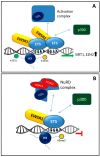Sequencing Overview of Ewing Sarcoma: A Journey across Genomic, Epigenomic and Transcriptomic Landscapes
- PMID: 26193259
- PMCID: PMC4519945
- DOI: 10.3390/ijms160716176
Sequencing Overview of Ewing Sarcoma: A Journey across Genomic, Epigenomic and Transcriptomic Landscapes
Abstract
Ewing sarcoma is an aggressive neoplasm occurring predominantly in adolescent Caucasians. At the genome level, a pathognomonic EWSR1-ETS translocation is present. The resulting fusion protein acts as a molecular driver in the tumor development and interferes, amongst others, with endogenous transcription and splicing. The Ewing sarcoma cell shows a poorly differentiated, stem-cell like phenotype. Consequently, the cellular origin of Ewing sarcoma is still a hot discussed topic. To further characterize Ewing sarcoma and to further elucidate the role of EWSR1-ETS fusion protein multiple genome, epigenome and transcriptome level studies were performed. In this review, the data from these studies were combined into a comprehensive overview. Presently, classical morphological predictive markers are used in the clinic and the therapy is dominantly based on systemic chemotherapy in combination with surgical interventions. Using sequencing, novel predictive markers and candidates for immuno- and targeted therapy were identified which were summarized in this review.
Keywords: Ewing sarcoma; bone neoplasm; bone tumor; epigenetics; immunotherapy; micro-environment; next generation sequencing; soft tissue tumor; splicing; targeted therapy.
Figures



Similar articles
-
[Functional genomics of Ewing sarcoma].Pathologe. 2017 Nov;38(Suppl 2):198-201. doi: 10.1007/s00292-017-0332-7. Pathologe. 2017. PMID: 28849372 Review. German.
-
Blocking the road, stopping the engine or killing the driver? Advances in targeting EWS/FLI-1 fusion in Ewing sarcoma as novel therapy.Expert Opin Ther Targets. 2014 Nov;18(11):1315-28. doi: 10.1517/14728222.2014.947963. Epub 2014 Aug 27. Expert Opin Ther Targets. 2014. PMID: 25162919 Review.
-
Primary subcutaneous spindle cell Ewing sarcoma with strong S100 expression and EWSR1-FLI1 fusion: a case report.Pediatr Dev Pathol. 2014 Jul-Aug;17(4):302-7. doi: 10.2350/14-03-1454-CR.1. Epub 2014 Apr 15. Pediatr Dev Pathol. 2014. PMID: 24735198
-
A novel CIC-FOXO4 gene fusion in undifferentiated small round cell sarcoma: a genetically distinct variant of Ewing-like sarcoma.Am J Surg Pathol. 2014 Nov;38(11):1571-6. doi: 10.1097/PAS.0000000000000286. Am J Surg Pathol. 2014. PMID: 25007147
-
Ewing sarcoma: biology-based therapeutic perspectives.Pediatr Hematol Oncol. 2012 Feb;29(1):12-27. doi: 10.3109/08880018.2011.627582. Pediatr Hematol Oncol. 2012. PMID: 22304007 Review.
Cited by
-
Ewing Sarcoma as Secondary Malignant Neoplasm-Epidemiological and Clinical Analysis of an International Trial Registry.Cancers (Basel). 2022 Nov 30;14(23):5935. doi: 10.3390/cancers14235935. Cancers (Basel). 2022. PMID: 36497417 Free PMC article.
-
Sudden unexpected death in a 17-year-old boy due to unacknowledged adamantinoma-like Ewing sarcoma.Forensic Sci Med Pathol. 2022 Dec;18(4):549-553. doi: 10.1007/s12024-022-00525-x. Epub 2022 Sep 21. Forensic Sci Med Pathol. 2022. PMID: 36129618 Free PMC article.
-
NKAP functions as an oncogene in Ewing sarcoma cells partly through the AKT signaling pathway.Exp Ther Med. 2019 Oct;18(4):3037-3045. doi: 10.3892/etm.2019.7925. Epub 2019 Aug 20. Exp Ther Med. 2019. PMID: 31555387 Free PMC article.
-
Poison-Exon Inclusion in DHX9 Reduces Its Expression and Sensitizes Ewing Sarcoma Cells to Chemotherapeutic Treatment.Cells. 2020 Jan 31;9(2):328. doi: 10.3390/cells9020328. Cells. 2020. PMID: 32023846 Free PMC article.
-
Ewing Sarcoma With Emphasis on Extra-skeletal Ewing Sarcoma: A Decade's Experience From a Single Centre in India.Clin Pathol. 2020 Nov 11;13:2632010X20970210. doi: 10.1177/2632010X20970210. eCollection 2020 Jan-Dec. Clin Pathol. 2020. PMID: 33241208 Free PMC article.
References
-
- De Alava E., Lessnick S.L., Sorensen P.H. In: Ewing Sarcoma in WHO Classification of Tumours of Soft Tissue and Bone. 4th ed. Fletcher C.D.M., Bridge J.A., Hogendoorn P.C.W., Mertens F., editors. IARC; Lyon, France: 2013. pp. 306–309.
-
- Le Deley M.-C., Delattre O., Schaefer K.-L., Burchill S.A., Koehler G., Hogendoorn P.C.W., Lion T., Poremba C., Marandet J., Ballet S., et al. Impact of EWS-ETS fusion type on disease progression in Ewingʼs sarcoma/peripheral primitive neuroectodermal tumor: Prospective results from the cooperative Euro-E.W.I.N.G. 99 trial. J. Clin. Oncol. 2010;28:1982–1988. doi: 10.1200/JCO.2009.23.3585. - DOI - PubMed
-
- Szuhai K., IJszenga M., de Jong D., Karseladze A., Tanke H.J., Hogendoorn P.C.W. The nfatc2 gene is involved in a novel cloned translocation in a Ewing sarcoma variant that couples its function in immunology to oncology. Clin. Cancer Res. 2009;15:2259–2268. doi: 10.1158/1078-0432.CCR-08-2184. - DOI - PubMed
Publication types
MeSH terms
Substances
LinkOut - more resources
Full Text Sources
Other Literature Sources

